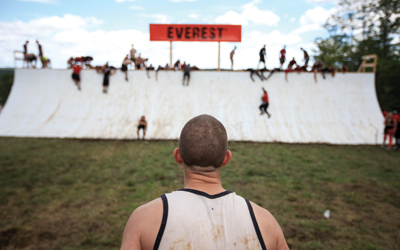When Alan Ali toed the line of his first 5K in July 2010 — the Susan G. Komen Race for the Cure in Raleigh, N.C. — he weighed more than 400 pounds.
“I imagined 5Ks were events that only fit people took part in,” Ali says. “As someone who is overweight, I never really thought I would fit in that type of environment.”
After a year of clean eating and exercise, Ali had already lost 50 pounds, from a starting weight of 480. His long-term approach to health was slow and methodical. He simply set small goals for himself, met each one and moved to the next. One of those goals was to walk a 5K.
“That race was difficult for me to sign up for,” remembers the 32-year-old, who now weighs 340 pounds and is still losing. “When I showed up the day of the event, I was almost in shock at the amount of people who were participating. I felt extremely out of place. I felt like I was the biggest person there.”
Once the race started, though, Ali could feel the crowd’s infectious enthusiasm and positive energy. That’s when, he says, “I knew I belonged.”
Ali also recalls being relieved to see so many other participants walking. “Deep down, I had a fear that I would be the only person not running and end up being the last person to finish the race.”
Crossing the finish line, he says, came with an amazing feeling: “Being overweight most of my life has caused me to put up walls around myself. That day, one of those walls came down.”
Like Ali, many people struggle to envision themselves “belonging” at a race. The thought of signing up for a 5K can be intimidating, and the idea of finishing one may seem insurmountable.
As Ali learned, though, no matter your fitness level, finishing a 5K is an accessible and realistic goal for almost everyone. And the rewards, both mental and physical, go way beyond earning a finisher’s T-shirt.
Here’s what you need to know (and do) to check that first 5K off your to-do list and feel the satisfaction of putting that finish line behind you.
Mind Over Matter
Most beginners, whether they’re starting from straight off the couch or have achieved a modest fitness base, already have the ability to walk, walk-jog or run a 5K. After all, it’s just a tiny bit over three miles — about an hour’s walk at a moderate pace. What they lack is the self-confidence to sign up for one.
Sara Vander Lugt, a resident of Shakopee, Minn., was a devoted walker and had even finished a 60-mile Susan G. Komen 3-Day walk. Still, she quietly dreamed of becoming a runner.
“Over the years, I tried to run,” the 50-year-old says. “The drill usually went something like this: Buy a new pair of running shoes, go out, try to run, get discouraged, give up.”
With two young daughters to raise, Vander Lugt started to think that running was not only an inspiring goal, but it would maximize the time she had to work out. Before committing, though, Vander Lugt says she had to quiet her inner skeptic — the one that said things like You can’t be a runner, You have bad knees, or You aren’t the athletic type.
“I have four older brothers who were all runners in high school, and I come from a family where girls’ athletics weren’t encouraged,” Vander Lugt says, explaining one of the roots of her subconscious doubt. “I needed to prove, mostly to myself, that I could do this.”
Last May, Vander Lugt downloaded the popular fitness app Couch-to-5K onto her smartphone (http://j.mp/ZERlDE) and embarked on a nine-week training regimen, with the intention of finishing a 5K that coming fall. But while she dutifully followed her fitness routines, she didn’t actually sign up for a run. Yet.
“I looked into a number of runs, many of which were local, but none really grabbed me,” Vander Lugt recalls. Then she comes clean: “More likely, I was procrastinating.”
In hindsight, Vander Lugt says her reluctance was rooted in unfounded insecurities. Mentally, she knew she could handle 3.1 miles, but she still couldn’t envision herself as a runner: “I think there was some underlying feeling that if I signed up and couldn’t actually run the whole way, I would have failed.”
Vander Lugt is far from alone. Countless people, no matter their body shape, are disinclined to call themselves “a runner.” Even the great Joan Benoit Samuelson, winner of the first Olympic women’s marathon in 1984, once reflected, “When I first started running, I was so embarrassed, I’d walk when cars passed me. I’d pretend I was looking at the flowers.”
Kristen Dieffenbach, PhD, an athletic coach and professor of athletic-coaching education at West Virginia University, says the anxieties, worries and concerns about entering an athletic “competition” vary from person to person and from event to event. The most common concerns include not knowing what to expect, not knowing anyone and not fitting in. And, as was the case for Vander Lugt, personal baggage can get in the way. “For some people, negative experiences with physical exercise or activity can also influence the anxiety,” Dieffenbach says.
Vander Lugt ultimately registered for the Buckshot Run in Eau Claire, Wis., where she was spending Labor Day weekend 2012 with family. “After I registered, I realized it was a two-mile run, not a 5K, and that seemed more doable,” she says. Still, she suffered from race-day anxiety to the point that she insisted her husband drop her off at the park entrance. “I wouldn’t even let my family come along.”
Vander Lugt says going forward and registering was “infinitely more difficult” than finishing the race. “The run itself was awesome. It was a beautiful, sunny day and it felt so good to be there, actually running,” she says. “I loved it, even despite being passed by a young kid in a wheelchair — twice! Those two miles really changed how I felt about my ability to run.”
Following the Labor Day race, Vander Lugt went on to finish a Turkey Day Trot later that fall and a 5K this past spring. She plans to sign up for a 10K later this summer. “I’ve even convinced my 8-year-old to try running with me,” she says.
Running Over Your Fears
The number of people who finish road races in the United States has grown to a record 13.9 million in 2011 from 5.2 million in 1991, according to statistics provided by Running USA. Of those races, 5Ks are the most popular, claiming 38 percent of finishers. And it’s a good guess that a lot of these folks initially experienced anxiety about the idea of lining up at the starting line.
So how did they do it? Well, many of them probably came to realize that instead of allowing their fear to immobilize them, they could leverage their fear to inspire forward motion.
Mind-body coach Kate Hanley, author of The Anywhere, Anytime Chill Guide, says there are two good ways to inspire action when the action feels scary.
“One way is to get present to the pain of not taking action,” she says. “It’s painful to disappoint yourself repeatedly, to continually talk yourself out of your dream.” In other words, at some point, you may find that not taking the steps to fulfill your goal of finishing a 5K is worse than whatever physical discomfort you might experience by actually walking or running those 3.1 miles.
The second (and perhaps more fun) way is to give yourself an inspiring vision of what will be different when you do finish the 5K. “This is more than the ‘Yes!’ moment of crossing the finish line,” Hanley says. It’s a matter of spinning your fear into a positive outcome, proving to yourself that you can get yourself over that mental hurdle. It’s calling on your inner strength, feeling part of a community of people who prioritize fitness, and trusting yourself to go after your goals.
Once you’ve overcome the fear of signing up, harness any remaining fear to get off the couch and on the move. Each time you walk or run a little bit farther — acknowledging your fear or desire to quit, and doing it anyway — you’ll find your self-confidence growing and your anxiety shrinking away.
Prepare for the Starting Line
One great way to get yourself ready for an athletic event is to embark on a good training program — one that gives you time to prepare both mentally and physically for the challenge you’ve chosen.
You can choose from solo or group training programs. “If you choose to train in a group, look for one with other beginners so you have runners of your pace to train with,” says Rebekah Mayer, USATF, RRCA, National Training Manager, Life Time Run. “A group that also has more-experienced runners can help you learn more about the sport, and [those runners] may become future training partners as you increase your pace and distance.”
Even if you prefer exercising alone, consider surrounding yourself with other people who are being active — whether at a gym or on a well-traveled outdoor trail. Or look for a supportive community online.
Seeking out like-minded, positive compatriots, ideally others who may be working toward similar goals, can be a powerful motivator. If you’re struggling with seeing yourself as a runner or believing you can cross that finish line, you’re more likely to be positively influenced by peers who are at the same level.
Encouragement from, and camaraderie with, a cadre of peers helped Denny Reid finish his first 5K. In all of his 68 years he had never competed in an athletic event. That’s not to say he wasn’t fit. Reid, from Raleigh, N.C., had worked himself up to running five miles on a treadmill over five years. In 2012 a personal trainer he was working with suggested he sign up for a 5K.
“I’ve been working out to stay healthy and had never really thought about entering a race,” Reid says. He chose the Life Time Commitment Day 5K on Jan. 1, 2013, because the event offered training and it was a fun run. “I knew people were going to be walking. It wasn’t a strict competition, so there was no anxiety about coming in last.”
Reid knew that he could cover the distance, but felt he needed the guidance of a training group. “After running inside all of the time on a treadmill, it’s a lot different when you hit the street,” Reid says. There’s varying terrain and elevation, along with the unpredictability of weather.
The once-a-week group training prepared him for that, and also taught him about pacing and running hills. “Intervals were a real challenge,” he remembers. “I did things I had never tried before and had a lot of fun. I found partners who were running my speed. There were nights it was cold, rainy and dark; I had never run in those conditions before and it reinforced my confidence.”
Dieffenbach says positive energy is a common side effect of group training. “Setting out and accomplishing a physical task with other people and sharing the struggle or the journey can be quite a bonding experience for many people,” she says, adding that the sense of group identity and co-motivation is palpable. “Even though they’re all physically completing the task on their own, they are psychologically helping each other.”
While some people join training groups to primarily build their fitness confidence, others are drawn as much or more to the social benefits. “For these folks, seeking out the support and camaraderie of others is a very important part of the experience,” Dieffenbach says.
Being connected with a group can also ease the anxiety on race day. And after the event, you can replay the experience with people who have been through it with you, step-by-step, and understand what you’ve accomplished.
The Thrill of the Finish
The emotional surge we feel after completing one event serves as both a reward for our lead-up efforts and an impetus for committing to the next big thing.
“You have a great time, you make connections, and you increase the likelihood you’ll keep going because participating in the event was intrinsically rewarding,” says Gary Barber, a running coach in British Columbia and author of Sports Psychology for Runners.
That’s what Denny Reid found. He ran in the middle of the pack during his first 5K but, thanks to his training, finished faster than he expected. “I felt quite a sense of accomplishment,” he says. Since then, athletic events have become a regular part of his fitness program, and he continues to go to his club’s Tuesday night fun run. Later this year, he plans to join another 5K training program and hopes to sign up for an indoor triathlon in October.
Reid is quick to point out that if he can do his first race at age 68, almost anyone can finish a 5K.
“There’s nothing to be afraid of. It’s lots of fun; families are out there; people are walking and running,” he says. “You’re going to make it. Find a friend. Go finish. Have some fun.”
Training, Start to Finish
Getting ready for your first 5K, even if you’ve been spending most of your time in a recliner, can be accomplished in a manageable amount of time. The Couch-to-5K training app (http://j.mp/ZERlDE) suggests you commit to three training days a week, 30 minutes each, for nine weeks before the event. If you already have some walking or running fitness, you might be ready in four to six weeks.
Ultimately, you want to be able to cover 3.1 miles confidently. Whether you plan to run, jog or walk (or do some combination of the three), work your way up to the distance slowly and gently. The gist of the program involves gauging what you’re capable of doing comfortably, and then gradually adding increments of time to each workout.
A funny thing will happen when you do: It’s called athletic adaptation. What you thought was hard two weeks ago will become nearly effortless, and eventually the 5K will become eminently doable, both mentally and physically.
If you’d like to finish a 5K without walking, check out the training schedule provided in “3 Months to Your First 5K”, a plan written by Dave Kuehls, author of 3 Months to Your First 5K. It includes training plans for those who have specific time goals in mind.




This Post Has 0 Comments